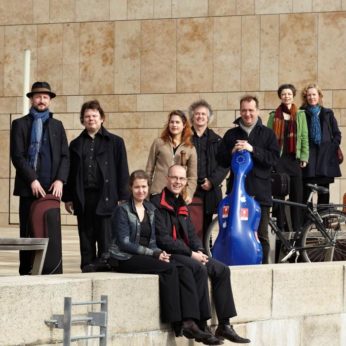Composer: Johann Sebastian Bach (b. 1685 - d. 1750)
Performance date: 03/07/2016
Venue: St. Brendan’s Church
Composition Year: circa 1718-23
Duration: 00:19:04
Recording Engineer: Richard McCullough, RTÉ lyric fm
Instrumentation: 2vn, 2va, 2vc
Instrumentation Category:Baroque Ensemble
Instrumentation Other: ob, 3vns, va, hpd, S-solo, thb
Artists:
Carolyn Sampson -
[soprano]
Concerto Copenhagen (Antoine Toruncyzk [oboe], Fredrik From, Peter Spissky, Antina Hugosson [violins], Torbjörn Köhl [viola], Judith-Maria Blomsterberg [cello], Kate Hearne [cello, recorder], Marrias Frostenson [bass], Fredrik Bock [theorbo], Marcus Mohlin [harpsichord]) -
[baroque ensemble]

Johann Sebastian
Bach’s secular cantatas fell into limbo after the composer’s death and were
only re-discovered a few years after the church cantatas. For a long time they
were considered of little consequence but numerous indications prove that Bach
considered them as important as his other works. We can only presume that more
than the four cantatas such as BWV 202 were written that fall into the category
of Wedding Cantatas, however, even
out of the four works we know, only two have survived. In fact it is only
through chance that we have a copy of BWV 202 – in 1730 a thirteen year-old
schoolboy, Johannes Ringk copied the manuscript signed by Bach, and although we
do not know the origin or date of the work, nor the identity of the couple or
poet, certain stylistic features point towards the work dating from the Köthen
period. Recent literary scholarship has assigned the text to Salomo Frank,
Weimer court poet who provided most of Bach’s libretto during the time.
It is presumed that
Bach wrote this music for a couple close to his own age and station due to the
lack of mention of nobility, rank or learned profession in the text. Some
scholars have even suggested the cantata was written for his own wedding to
Anna Magdelena in 1721 and have gone so far as to propose that she might have
sung it herself. It is scored for solo soprano and strings, punctuated by wind
instruments. The recitatives are very free in style with secco beginnings accompanied solely by the continuo group, and they
end in an arioso style – melodically and rhythmically flexible – typical of
Köthen cantatas. The poem portrays the vernal rebirth of nature, the unexpected
appearance of Phoebus and Cupid, celebrating the birth of love and ends with
inevitable good wishes.
The opening aria
begins with one of Bach’s best exhibitions of descriptive music. The strings
introduce a dreamy spring melody in the oboe, with the voice then calmly and
sweetly overcoming the strings. The second aria contains
a bouncing continuo line evoking the image of Phoebus riding on his chariot. In
contrast to this, the steady pace of the violin in the third aria depicts Cupid
creeping forward to witness and relish the happiness he has brought. The fourth
aria is a swaying triple-metre dance followed by the conclusive Gavotte aria
which more than likely had another section than the singular strophe that
survives as the singer does not come in until the middle with variations on the
Gavotte theme.
Copyright © 2024 West Cork Music. All rights reserved.
Designed and developed by Matrix Internet